The Milk Clarifier Market is estimated to be valued at USD 1225.4 million in 2025 and is projected to reach USD 2093.2 million by 2035, registering a compound annual growth rate (CAGR) of 5.5% over the forecast period.
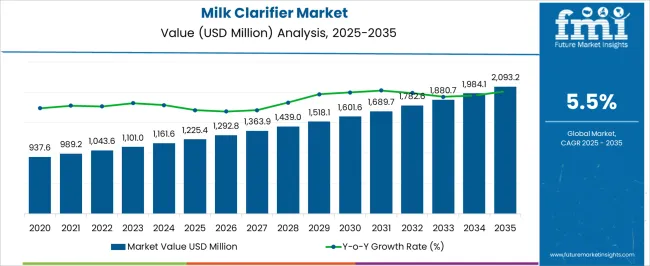
| Metric | Value |
|---|---|
| Milk Clarifier Market Estimated Value in (2025 E) | USD 1225.4 million |
| Milk Clarifier Market Forecast Value in (2035 F) | USD 2093.2 million |
| Forecast CAGR (2025 to 2035) | 5.5% |
The milk clarifier market is undergoing consistent growth driven by increasing demand for higher milk quality and improved dairy processing efficiency. Rising consumer awareness regarding milk purity and the need to remove impurities and sediments have fueled adoption across dairy producers globally.
Technological advancements in clarification processes have enhanced the operational performance of milk clarifiers, enabling better separation and reduced product loss. Sustainability considerations and stringent food safety regulations are also contributing to the shift towards more efficient clarifying equipment.
Future growth prospects are expected to be supported by expanding dairy consumption, modernization of dairy farms, and integration of automation within dairy processing facilities. Collaborations between equipment manufacturers and dairy enterprises to customize clarifier solutions are further facilitating market penetration, enabling scalability and cost-effectiveness across various production scales.
The market is segmented by Product Type and End Use Application and region. By Product Type, the market is divided into Cold Milk Clarifier and Hot Milk Clarifier. In terms of End Use Application, the market is classified into Plain Milk, Skim Milk, and Others. Regionally, the market is classified into North America, Latin America, Western Europe, Eastern Europe, Balkan & Baltic Countries, Russia & Belarus, Central Asia, East Asia, South Asia & Pacific, and the Middle East & Africa.
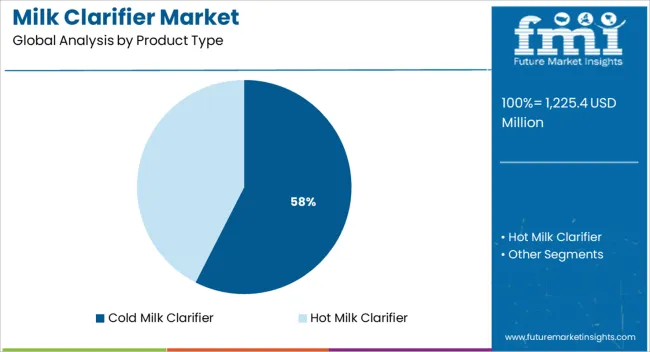
When segmented by product type, the cold milk clarifier segment is expected to hold 57.5% of the total market revenue in 2025, establishing it as the dominant product type. This prominence is attributed to its effectiveness in maintaining milk quality at lower temperatures, which helps in preserving nutritional and sensory properties while efficiently removing impurities.
The adoption of cold milk clarifiers has been accelerated by the need to comply with stringent hygiene standards and extend the shelf life of milk products. Operational advantages such as reduced microbial growth and improved energy efficiency have been significant factors driving its preference over traditional clarification methods.
Furthermore, technological refinements that enable seamless integration with existing dairy processing lines have strengthened the segment’s leadership position.
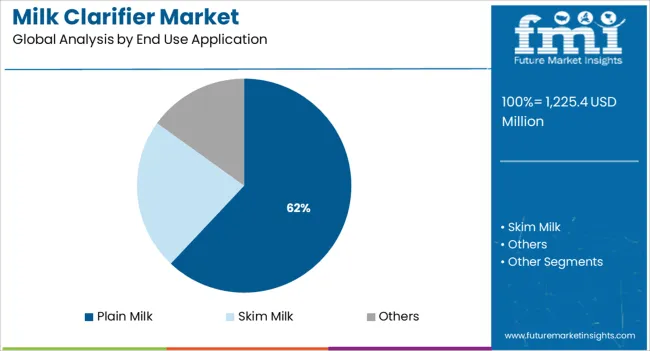
Segmented by end use application, plain milk is projected to capture 62.0% of the market revenue in 2025, making it the leading application segment. This leadership is driven by the high consumption rates of plain milk worldwide and the critical need for ensuring its purity and safety before distribution.
Dairy processors have increasingly adopted clarifiers to remove suspended solids and contaminants that can affect milk quality and consumer health. The preference for plain milk in both retail and institutional settings has necessitated investments in advanced clarification equipment to meet quality assurance standards.
Operational benefits such as improved product consistency, reduction in downstream filtration requirements, and compliance with food safety regulations have reinforced the dominance of this segment in the milk clarifier market.
As per FMI, over the past five years (2020 to 2024), the global milk clarifier market exhibited steady growth at a CAGR of 4.6%. Growth is mainly attributed to the emergence of efficient, automatic, well-controlled, and self-cleaning milk clarifiers by key companies worldwide.
The milk clarifier market is projected to grow at a faster rate than average due to the rapid expansion of the global dairy processing industry. Demand for automatic and semi-automatic milk clarifiers is projected to surge at a fast pace among end-use industries in the next ten years.
The ability of milk clarifiers to provide adequate flow cross-sections, low feed pressure, great flexibility in terms of feed quantity, and gentle product treatment is also projected to boost the global market in the next ten years. In addition to that, no air gets trapped inside these products due to their innovative designs.
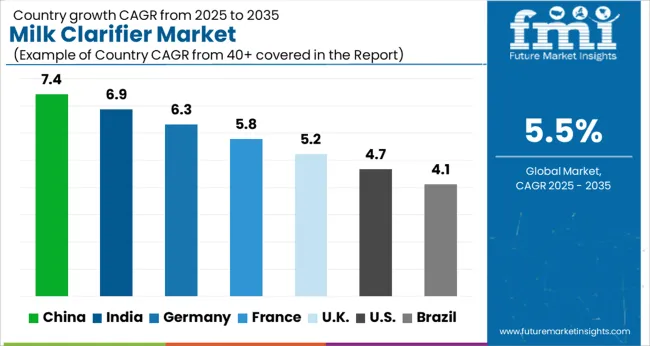
Launch of New Products in the USA to Augment Sales of Clarifiers in the Dairy Industry
According to FMI, the USA milk clarifier market is estimated to account for a share of nearly 68% in the forecast period from 2025 to 2035. The country is projected to create an absolute dollar opportunity of USD 284.5 Million in the next ten years.
USA-based manufacturers are set to launch new products based on consumer insights at regular intervals. They are investing huge sums in research and development activities to come up with technologically advanced products. This factor is likely to bode well for the USA milk clarifier market.
India-based Milk Start-ups to Look for Novel Milk Clarification Machinery by 2035
The increasing population is one of the major factors that is projected to push the Indian milk clarifier market in the evaluation period. Milk companies are showcasing high demand in the country with the surging need for various dairy products.
India is considered to be one of the largest milk-consuming countries. It is thus compelling medium and small-sized companies to partake with their international rivals. More and more start-ups are set to be born in the Indian milk clarifier market with organized supply-chain management.
Major players are looking to establish their presence in the Indian market during the forecast period.
Constant Product Upgradation in China to Push the Demand for Clarification in Milk
According to FMI, the China milk clarifier market is set to generate a considerable share of about 32% in the forecast period. Chinese consumers are very much interested to test new products, which would push the rate of innovation from various manufacturers.
Greater devolvement potential, rising trend of product upgrades & addition, and the presence of major companies are expected to have a positive impact on the demand for milk clarifiers in China. Owing to the aforementioned factors, the China milk clarifier market is estimated to reach a valuation of USD 2093.2 Million by 2035.
International Companies Based in the UK to Utilize Milk and Whey Clarifiers
According to FMI, Europe is set to hold a share of around 32% of the milk clarifier market by the end of 2035. The region is projected to create an incremental opportunity of about USD 1225.4 Million from 2025 to 2035. In Europe, the UK is considered to be a lucrative market with the presence of several local and international players.
Demand for Skim Milk Clarifiers to Surge at a Rapid Pace during the Forecast Period
By application, the skim milk segment is anticipated to remain at the forefront of the global milk clarifier market in the evaluation period. The surging adoption of skimmed milk powders is projected to drive the segment.
Also, the rising popularity of social media marketing, labeling strategy, and omnichannel retailing tactics is likely to bode well for the skim milk segment in the next ten years.
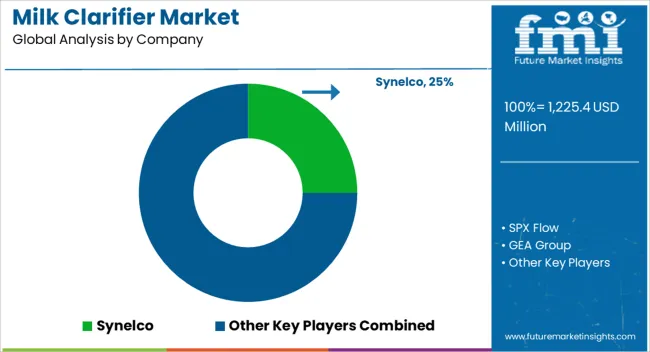
The global milk clarifier market is highly fragmented with the presence of various international and regional players. Major players around the world are focusing on the development of cost-effective milk clarifiers to meet the rising demand from end users.
In addition, some of the leading players are providing customized solutions to cater to the rapidly evolving demand of their clients.
How Milk Clarifiers by Alfa-Laval-Ab, GEA Group AG, and Kroners AG Keep Dairy Products Safe and Efficient?
Milk clarifiers are a good way for companies to make their milk safe for consumers. The benefits of using milk clarifiers include easy sanitation, quick production time due to less time spent cleaning equipment, and the potential to produce less waste.
Dairy product manufacturing companies also use these clarifiers in order to ensure that they have an adequate supply of clean milk on hand so that they can continue to provide good quality products.
Alfa Laval is a global leader in the production of high-quality products for heat transfer, separation, and fluid handling. The company is taking various initiatives in order to improve its clients' productivity and competitiveness across a wide range of global sectors.
In particular, in the field of energy, environment, food, and maritime, the company creates sustainable goods and solutions that match their needs.
The company also offers a wide range of milk clarifying systems for both fresh milk production and cheese manufacturing that includes ultrafiltration, nanofiltration, reverse osmosis, and evaporative techniques.
Additionally, Alfa Laval Twin Screw Pump is the company's latest addition to its hygiene pump range for usage in the field of dairy, food, beverage, and personal care.
The twin screw pump is specially designed for process flexibility and is constructed on a durable, dependable base that fulfills high hygiene standards. It includes numerous innovative characteristics such as a low pulsation characteristic, outstanding solids handling capabilities, and improved suction performance, that provide customers with greater process flexibility, high dependability, quick & easy maintenance, and increased operating safety.
The high-performance D Series separators from Alfa Laval, on the other hand, were primarily designed for the needs of milk and whey clarification in the field of dairy. The series includes a wide range of variants to satisfy numerous capacity requirements, as well as unique technologies that assure efficient, dependable, and cost-effective separation.
GEA is a global systems provider in the field of food, beverage, and pharmaceuticals. The company's portfolio comprises machinery and facilities, as well as modern process technologies, components, and complete services.
They are used by a wide variety of end users to improve the sustainability and efficiency of manufacturing processes across the world. GEA's goal is to provide its clients with long-term value creation and ideas for future success.
GEA's innovative milk clarifier technology is based on the company's extensive experience with dairy plants and its world-leading expertise in separation, classification, and filtration. These technologies were used to develop a new generation of products for producing high-quality skimmed milk that meets stringent international hygiene standards.
Similarly, Krones AG is a German producer of packaging and bottling machines. It manufactures new lines for filling beverages into plastic, glass, or beverage cans. Stretch blow-molding machines for creating polyethylene terephthalate (PET) bottles, as well as fillers, labelers, bottle washers, pasteurizers, inspectors, packers, and palletizers, are manufactured by the firm.
Material flow systems and process technologies for generating beverages for brewers, dairies, and soft-drink firms round out the product line. Krones Inc. announced the formation of the Krones Process Group North America to deliver a more integrated offering to the North American, Central American, and Caribbean beverage, dairy, and food companies.
| Attribute | Details |
|---|---|
| Estimated Market Size (2025) | USD 1225.4 million |
| Projected Market Valuation (2035) | USD 2093.2 million |
| Value-based CAGR (2025 to 2035) | 5.5% |
| Forecast Period | 2025 to 2035 |
| Historical Data Available for | 2020 to 2024 |
| Market Analysis | Value (USD Million) |
| Key Regions Covered | North America; Latin America; Europe; Asia Pacific; Oceania; Middle East and Africa (MEA) |
| Key Countries Covered | USA, Canada, Mexico, Germany, UK, France, Italy, Spain, China, Japan, India, South Korea, Australia, Brazil, Argentina, South Africa, UAE |
| Key Segments Covered | Product Type, Application, Region |
| Key Companies Profiled | Synelco; SPX Flow; GEA GROUP; ANDRITZ Frantech; Tetra Fak; Alfa-Laval |
| Report Coverage | Market Forecast, Company Share Analysis, Competitive Landscape, Drivers, Restraints, Opportunities and Threats Analysis, Market Dynamics and Challenges, and Strategic Growth Initiatives |
The global milk clarifier market is estimated to be valued at USD 1,225.4 million in 2025.
The market size for the milk clarifier market is projected to reach USD 2,093.2 million by 2035.
The milk clarifier market is expected to grow at a 5.5% CAGR between 2025 and 2035.
The key product types in milk clarifier market are cold milk clarifier and hot milk clarifier.
In terms of end use application, plain milk segment to command 62.0% share in the milk clarifier market in 2025.






Our Research Products

The "Full Research Suite" delivers actionable market intel, deep dives on markets or technologies, so clients act faster, cut risk, and unlock growth.

The Leaderboard benchmarks and ranks top vendors, classifying them as Established Leaders, Leading Challengers, or Disruptors & Challengers.

Locates where complements amplify value and substitutes erode it, forecasting net impact by horizon

We deliver granular, decision-grade intel: market sizing, 5-year forecasts, pricing, adoption, usage, revenue, and operational KPIs—plus competitor tracking, regulation, and value chains—across 60 countries broadly.

Spot the shifts before they hit your P&L. We track inflection points, adoption curves, pricing moves, and ecosystem plays to show where demand is heading, why it is changing, and what to do next across high-growth markets and disruptive tech

Real-time reads of user behavior. We track shifting priorities, perceptions of today’s and next-gen services, and provider experience, then pace how fast tech moves from trial to adoption, blending buyer, consumer, and channel inputs with social signals (#WhySwitch, #UX).

Partner with our analyst team to build a custom report designed around your business priorities. From analysing market trends to assessing competitors or crafting bespoke datasets, we tailor insights to your needs.
Supplier Intelligence
Discovery & Profiling
Capacity & Footprint
Performance & Risk
Compliance & Governance
Commercial Readiness
Who Supplies Whom
Scorecards & Shortlists
Playbooks & Docs
Category Intelligence
Definition & Scope
Demand & Use Cases
Cost Drivers
Market Structure
Supply Chain Map
Trade & Policy
Operating Norms
Deliverables
Buyer Intelligence
Account Basics
Spend & Scope
Procurement Model
Vendor Requirements
Terms & Policies
Entry Strategy
Pain Points & Triggers
Outputs
Pricing Analysis
Benchmarks
Trends
Should-Cost
Indexation
Landed Cost
Commercial Terms
Deliverables
Brand Analysis
Positioning & Value Prop
Share & Presence
Customer Evidence
Go-to-Market
Digital & Reputation
Compliance & Trust
KPIs & Gaps
Outputs
Full Research Suite comprises of:
Market outlook & trends analysis
Interviews & case studies
Strategic recommendations
Vendor profiles & capabilities analysis
5-year forecasts
8 regions and 60+ country-level data splits
Market segment data splits
12 months of continuous data updates
DELIVERED AS:
PDF EXCEL ONLINE
Milk Froth Thermometer Market Size and Share Forecast Outlook 2025 to 2035
Milk Carton Market Size and Share Forecast Outlook 2025 to 2035
Milking Automation Market Size and Share Forecast Outlook 2025 to 2035
Milking Robots Market Size and Share Forecast Outlook 2025 to 2035
Milk Packaging Market Size and Share Forecast Outlook 2025 to 2035
Milk Homogenizer Machine Market Size and Share Forecast Outlook 2025 to 2035
Milk Pasteurization Machines Market Size and Share Forecast Outlook 2025 to 2035
Milk Sterilizer Machine Market Size and Share Forecast Outlook 2025 to 2035
Milk Powder Packaging Market Size and Share Forecast Outlook 2025 to 2035
Milk Powder Packaging Machines Market Size and Share Forecast Outlook 2025 to 2035
Milk Protein Market - Size, Share, and Forecast 2025 to 2035
Milk Ingredients Market Analysis - Size, Share, and Forecast Outlook 2025 to 2035
Milk Mineral Concentrate Market Trends-Demand, Innovations & Forecast 2025 to 2035
Milk Thistle Market Analysis by Form, Distribution Channel and Region through 2035
Milk Powder Market Analysis by Type, Distribution Channel, Region and Other Applications Through 2035
Milk Tank Cooling System Market Growth – Trends & Forecast 2025 to 2035
Milk Alternatives Market – Growth, Demand & Dairy-Free Trends
Milk Protein Hydrolysate Market Growth - Infant Nutrition & Functional Use 2024 to 2034
Milking Equipment Market
Milk Bottle Market Trends & Industry Growth Forecast 2024-2034

Thank you!
You will receive an email from our Business Development Manager. Please be sure to check your SPAM/JUNK folder too.
Chat With
MaRIA